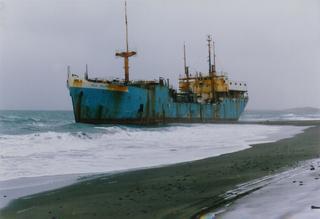
Whether you believe a group of fishermen can get it together enough to go it alone on processing and marketing or not, here's proof it can be done.
Floating processing is not risk free. But then this is on the north shore of St. Paul Island. Not a forgiving place.
Kodiak setnetters got together and brought in a floating processing ship. And they sell to a good broker, who has 1200 or so restraunts and seafood counters to tap into. A lot of brokers don't have direct contact with retailers and chefs. But I think these are finding that to stay in business it's becoming more necessary.
Gone are the days of phone booth brokerage. They would talk themselves in for 10 percent with just a single line phone. And if you weren't careful, they would sell the product when it got to Seattle and that's the last you would see of the fish or the money. Most all of the Juneau fishermen have gone through that exercise.
There are risk reduction procedures that banks and others use to make this possibility about nil. Look for more fishermen groups following suit. There is a small fishermen's group in Southeast Alaska that bought the old "Blue Wave," a large floater, to process their seine fish. One seiner in Southeast could just about keep the average floater busy all by himself.
If they can get the 58 foot limit lifted from the seine fleet, heading and gutting could be accomplished on board the catcher vessel. Then the fish has a chance of not getting belly burnt through transportation and handling procedures that wouldn't otherwise be possible. Tuna seiners work like this. They brine freeze the fish whole on board so they can run all the way from Africa.
There's still a limit on the seine size, but giving fishermen a chance to do something other than sell to a shore based middleman would be a great step forward. The shore plants aren't hiring local labor much anymore anyway.
It used to be housewives and college kids who manned the canneries. Just look at the the men's room door at the local processing plant and it'll probably say "hombre." Those wages aren't staying in the community for the most part. The old arguements for processing in the community just don't hold much water anymore.
It's a complicated mix of local and world economic arguements. Just look at the controversy in B.C. with their 25 cent stumpage on trees. The only sense I got out of reading a "TheTyee" article and a lot of comments, was that it's too hard for the average person to make any sense out of it. But it did seem like the politics was fearsome, to the detriment of the communities that live amongst the trees.
Is there a comparison to the communities in Alaska that exist amongst the fish? How loud does big business really talk?


0 Comments:
Post a Comment
<< Home